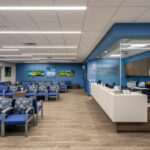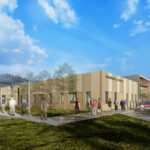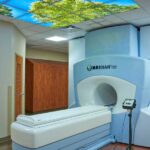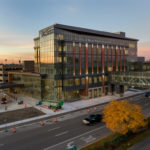Adopting integrated, EBD approach improves delivery of care
Historically, cancer care has been siloed in a healthcare delivery setting, requiring patients to see oncologists, radiologists and surgeons separately, often in varying areas of a facility or another building entirely. Today, these three disciplines work together and meet weekly, sometimes daily, to consult on treatment plans — allowing cancer care delivery to become more integrated under one roof.
While co-location of services is nothing new, moving patients to different points of care has shifted to moving the care to the patient. This has provided new context for facility design as architects and designers are now designing for not only cancer care, but the ever-expanding group of subspecialties that accompany it. In this continuum of care delivery model, practitioners share the same clinical and support spaces. Therefore, it’s important to build spaces that continue to prioritize mainstays in cancer care design, focus on reducing stress in the patient experience and include universal design strategies and adaptable, flexible environments.
Over the next decade, the Centers for Disease Control expects a 20% increase in cancer cases, generally due to the aging population, underscoring the criticality of well-designed facilities that support this paradigm shift in care delivery.
Adopting an integrated approach to care delivery
Generally, architects and designers work to design facilities that best support care delivery, considering operational necessities, the treatment itself and its effect on patients and how physicians and patients interact.
Today, there are many different components to cancer care that are critical, including clinical, imaging services, telehealth services, research, labs, clinical trials, cancer patient-specific urgent care, palliative care and survivorship, among others. The integrated approach combines these services with standard treatments under the umbrella of oncology, radiology and surgery, allowing physicians to work cohesively with case management, for the betterment of the patient.
With the integrated approach comes adjustments to the physical treatment spaces. Designers must create spaces which allow each subspecialty to exist and operate in harmony by combining all services together, not just co-located in a single building. For example, a consult room may be a space within the exam room to support the ability to bring administration services to the bedside.
Taking cues from healthcare practices with Evidence-Based Design
Evidence-Based Design is a common method in the design of healthcare facilities, derived from the practice of evidence-based care, which drives medical and care delivery decisions based on research. EBD utilizes research that links the human condition to the physical environment and considers which environmental factors can best support operations and the wellness of the patient, aid in the reduction of medical errors, improve patient safety and improve overall patient outcomes.
The implementation of EBD can promote healing and improve patient outcomes in a variety of ways, and can be categorized by the potential benefit; reducing stress, preventing injury, reducing errors, supporting operations and supporting staff. There are several research-based ways to reduce patient stress and promote a sense of well-being, and in cancer care, it manifests in many ways, but particularly in the human brain and the body’s innate connection to nature. Many aspects of cancer care facilities are rooted in biophilia, prioritizing access to sunlight, fresh air, views of nature and live plants, which can have a positive impact on patient recovery. To prevent injury, patient lifts and non-slip flooring may be installed. To prevent infection, providing hand-washing sinks for staff, installing HEPA filters and the separation of clean and dirty material flows are critical. To best support staff, reducing travel distances and providing staff respite spaces are particularly important.
Prioritizing the patient experience
Cancer can be a fast-acting and grueling disease, and can affect patients differently, resulting in a spectrum of symptoms and abilities. For this reason, designers must prioritize the patient experience and be cognizant of the ways in which it should accommodate patients’ differing needs.
To cater to the spectrum of patient needs, it is important to provide a variety of spaces and conditions, particularly for infusion pods. Patients, depending on symptoms and illness, will have preferences on where they receive infusions, so cancer care facilities should consist of a range of environments to optimize comfort for each patient. While some patients may relish the opportunity to take in sunlight, others may require darkness for sleep and rest. Some may be interested in socializing with other patients, while others may prefer a more quiet, private space. Other variables include duration of stay and mobility.
As patients going through chemotherapy may have cognitive impairment to some degree, as well as limited walking abilities, wayfinding is an important aspect of cancer care design. Due to the large and complex nature of hospitals, they can often have unclear signage, confusing hallways and difficult-to-navigate parking, which can instill unnecessary stress on patients and contribute to a longer healing process. To combat this, cancer care facilities require clear and natural wayfinding tools. Providing patient drop-offs and reception areas within line of sight from the front door is the first step for minimizing confusion.
A well-designed wayfinding system incorporates signage in conjunction with strong visual clues through the use of color, pattern and texture to direct patients to different departments and areas of the building. When possible, eliminating navigation altogether can offer a solution by making it possible for subspecialties to travel to the patient or offer telehealth appointments. While patient recovery is based on many factors, designers should be aware of the ways in which facility design can help negate stressors that could lengthen a patient’s recovery period.
Continuing to improve cancer care facilities
With the development of new imaging technologies, novel therapies, use of AI, expansion of clinical trials and more complex pathology labs, the cancer center must continue to evolve. Evidence-based strategies for prevention, early detection, diagnosis, treatment and palliation have expanded to include more robust patient support services including case management, connection to cancer care networks and family support services. Resulting from this desire to provide holistic patient care, cancer centers are starting to incorporate family spaces. There is much to learn about cancer as a disease and the treatments used to fight it, and families are often in search of education materials. Moving forward, waiting room areas will be more of a continuum, with educational touchpoints becoming increasingly integrated into the experience.
Oncology emergency departments are also on the rise to provide a more calm, less crowded and easy to access environment. These EDs are separate from a hospital setting and catered to cancer patients and their specific symptoms, simplifying the approach to EDs as much as possible.
While it is difficult to predict medical advances that may affect facility design in the future, these innovations in cancer care facility design are changing the landscape for the better.
Photos courtesy of NELSON Worldwide



















